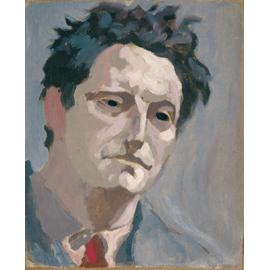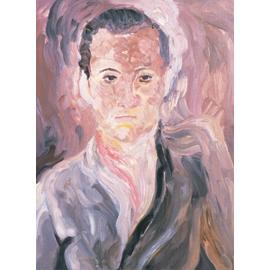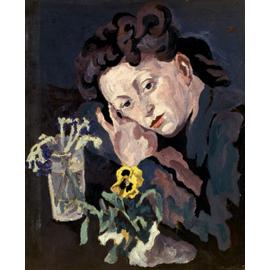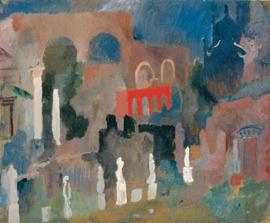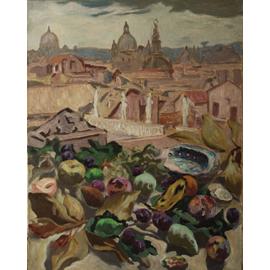Carlo Levi And Roma. “Il Respiro Della Città” (The Breath Of The City)

The “Casino dei Principi” in Villa Torlonia, is hosting an exhibition that depicts the relationship that Levi had with Rome by comparing his work to that of artists from the Roman School.
A total of 46 paintings done by Carlo Levi between 1926 and 1954 will be on display along with 28 paintings done by various artists from the Roman School including Pirandello, Mafai, Scipione, Trombadori, Afro, Ferrazzi, Scialoja, Melli and Capogrossi and the exhibition is designed to show the work of this artist and intellectual from Turin in a completely new light. It begins with the work he completed before 1930, the period in which Levi found himself included in the short-lived group of 6 artists known as the “Turin Six”, and it goes on to compare his paintings from the30s and 40s with those of artists he met in Rome during that time.
In 1931 Levi exhibited at the Rome gallery of Pier Maria Bardi and at the 1st Rome Quadrennial. It was probably then that he noticed that the artistic culture of the city was undergoing huge changes. To cite Libero de Libero “personalities were beginning to appear, young people who had nothing to do with the rhetoric about a formal return to Italian traditions who were using painting and sculpture to seek out authentic values; subjects had to be treated with the greatest expressivity possible”.
During his time in Rome, Levi’s paintings changed and he moved away from the clear / open style of the “six” and took on new ideas, this time “Roman” in origin and from the international art culture, absorbed during his many trips to Paris between 1921 and 1941 thanks to his involvement with the Rosselli brothers and his membership of the Justice and Freedom movement. His art took on a stronger chromatic timbre, his brushstrokes were more robust and his work became progressively more visionary.
The objects shown in the still life’s he painted during this period seem to break away from the limpid transparency of the background, and he started to move away from using the pearly tones seen in “Mattino” (morning – 1929) to others that were brighter and more “expressionist” as in “Still life with pomegranates”, “Still life with bottle” and “The Red Fruit” (1930)
The still-life paintings done between 1932 and 1933 have much in common with Scipione’s typically more dynamic style which Levi takes further still by applying thicker paint (“Talc and biscuits”, 1932 and “Morandi’s Reluctant Lover”) and using undulating brushstrokes.
At the same time, his landscapes became more evocative and visionary: think of the atmosphere in his Roman Landscape with red arches (1931) that echo the paintings done by Mafai and Scipione in the same period.
It is possible to consider artists of the Roman School – despite their individual idiosyncrasies – and Levi in the same light because the subjects they painted were common to them all, but more than that, it was a search for a realism that was not purely illustrative that they shared; a realism based on the immediacy of the emotion and the simplicity of their observations. They also shared the desire to take up a place “in the here and now” and to reject the idea of schools and academies.
From the 30s onwards however, there are no significant changes in Levi’s work. His paintings remain within the realms of “essential naturalism” that he himself theorized about in a ‘32 text that has, until now, never been made public. He states that his painting style is not rational but rather the result of an intuitive approach to reality, paintings that can “only be understood because of their sentiment”, because it is that which brings them alive.
It is his portraits however – which he continued to produce on a regular basis throughout his lifetime – that best illustrate his completely subjective relationship with the world. For Levi, every portrait was first and foremost a reflection of himself and discovering the character and facial features of the subject were secondary. It means that both his portraits and self-portraits are actually different mental perspectives of his “ego” and “id”. In addition to the extraordinary self-portraits on display, visitors can also admire his portraits of Moravia (1932), Leone Ginzburg (1933), De Pisis, (1933) and Anna Magnani (1954).
It was not only Levi’s paintings that were deeply affected by prison, his life was too – Regina Coeli in Rome and the gaol in Lucania – about which he wrote that it was a world where women “know how to reap the corn, but know nothing about smiles”. The people he painted did not feel as if they belonged to him, they were from a world far away that he felt was “immerged in truth” represented by in an expressionist and feverish vortex.
Levi’s reaction to the war was to use his painting to explore his immediate reality; the people he loved, colleagues that (in this period) emerge from the background with greater strength and plasticity, often immersed in a melancholy atmosphere that is not a manifestation of resignation but rather awareness of the circumstances present. The still-life paintings from this period are, on the other hand, metaphors for a world overcome with tragedy and a premonition of death.
After the war, he moved to Rome on a permanent basis and brought the various strands of his life together: painting, writing and politics – in 1963 in fact he became a Senator of the Republic.
In the debate that raged between abstractionists and neo-realists, he sided with the latter. In a reflective piece written in 1942 entitled “Fear of Painting” he declared, “this conferral of reality, adding reality and actuality as a category to other aspects of the world, giving them a name and a shape has always been the very nature of art: it needs it, it is its existential value”.
In a period that was probably the least creative as far as his art was concerned, Levi’s writing peaked: in 1945 “Christ stopped at Eboli” was published and followed by “The Watch” in 1950, dedicated to the first few months he spent in Rome immediately after the war.
By comparing Levi’s work to that of his contemporaries, carried out at a time that the climate of 20th century life was being subjected to the anguish of war, this exhibition, “Carlo Levi e Roma: Il respiro della città” sets out the great need expressed by the artistic culture of the time to renew itself. A need expressed not only through the search for new aesthetic ideals but which imbued works with a deep sense of understanding and sharing in the destiny of man.
Palombi Editore
Information
9.00-16.30 until 28th february
9.00-17.30 from 1st march to 29th march
9.00-19.00 form 30th march to 30th september
closed on manday and 1st may 2008
The ticket office closes 45 minutes in advance
A single ticket includes the Casina delle Civette, the Casino Nobile and the Exhibition
€ 9,00 ordinary
€ 5,50 reduced
A single ticket includes the Casino Nobile and the Exhibition
€ 7,00 ordinary
€ 5,00 reduced
060608 (every day 9.00am - 10.30pm)
sponsored by Comune di Roma Assessorato alle Politiche Culturali, Regione Lazio, Provincia di Roma, Fondazione Carlo Levi e Archivio della Scuola Romana
Banche tesoriere, Vodafone
Press Room
Gallery
12602

Casino dei Principi






























